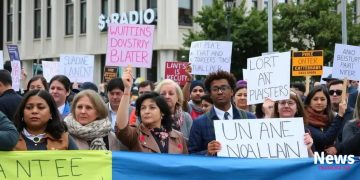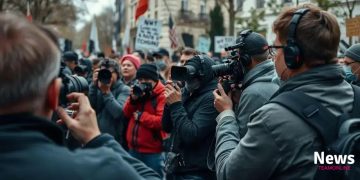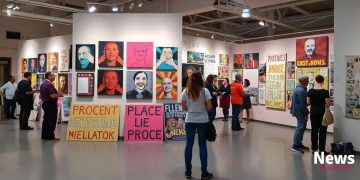Media framing in protest event coverage: why it matters
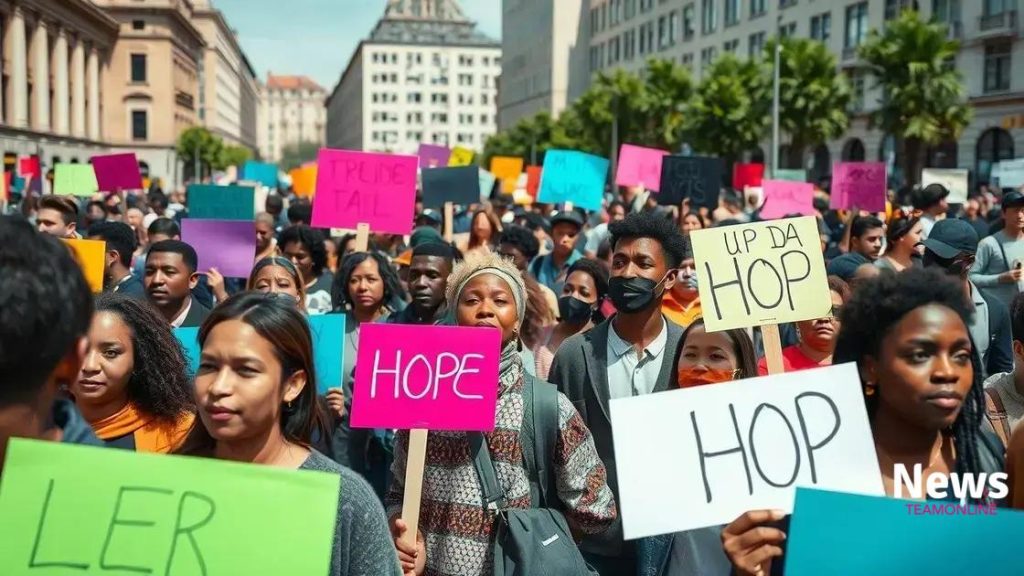
Media framing in protest event coverage significantly influences public perception by emphasizing certain narratives, using powerful visuals, and shaping the discourse through social media engagement, often leading to misinterpretation or heightened emotional responses.
Media framing in protest event coverage plays a vital role in how we perceive social movements. Have you ever noticed how different reports can tell entirely different stories? Let’s explore the nuances behind this phenomenon.
Understanding media framing techniques
Understanding how media framing techniques influence public perception is essential in today’s information age. Media framing shapes how we interpret events, especially protests. By focusing on specific aspects of a protest, media can evoke certain emotions and opinions from the audience.
What are media framing techniques?
Media framing refers to the way news stories are presented and structured. Different frames can highlight different elements of the same event, leading to varying interpretations. For example, a protest may be framed as a fight for justice or as a disturbance of public order. This simple shift in focus can alter public opinion significantly.
- The use of language plays a crucial role in framing.
- Visual elements, such as images or videos, can enhance certain narratives.
- The choice of sources and quotes can impact the credibility of the coverage.
- Context provided in the report sets expectations for the audience’s reaction.
By comprehending these techniques, consumers of media can become more critical of the information they receive. Recognizing that the same protest can be depicted in various ways challenges us to seek multiple viewpoints.
Examples of framing in action
Consider two articles covering the same protest event. One might emphasize the peaceful nature of demonstrators, while the other focuses on clashes with law enforcement. This choice dictates how the public perceives the event. Media outlets may select images that either humanize protesters or depict them as unruly. Such decisions heavily influence audience reactions, whether one feels empathy or fear.
All these elements come together to create a narrative that can sway public opinion. When studying past protests, we learn that the framing can lead to different societal impacts. For example, protests framed as social justice movements have historically garnered more support, as opposed to those labeled as riots.
The role of media in shaping protest narratives
The role of media in shaping protest narratives is significant. Media outlets have the power to influence what stories are told and how they are perceived. When a protest occurs, the coverage can highlight specific events, voices, or perspectives, thus framing the entire narrative.
How media coverage frames events
Media coverage can transform a protest into a powerful symbol or a chaotic scene. The choice of words, images, and quotes all contribute to the narrative being constructed. For example, using terms like “riot” can incite fear, while “peaceful demonstration” fosters understanding.
- Amplifying specific voices can shift public support.
- Highlighting conflicts may generate negative perceptions.
- Focusing on peaceful actions promotes solidarity.
- Audience interpretation varies based on media framing.
Understanding this role helps us recognize inherent biases in reporting. When a headline slants toward a particular viewpoint, it sets the tone for how the public perceives the entire event. As a result, two different outlets can present starkly different images of the same protest.
Impact of editorial choices
The decisions made by editors and journalists can also impact public sentiment. Tools such as visuals, statistics, and expert opinions can either support or undermine the protest’s legitimacy. For instance, including background information about the causes behind the protest helps give context, allowing audiences to engage more deeply with the issues.
Beyond this, social media platforms have added another layer to how narratives are formed. With instant sharing of images and stories, any protest can quickly go viral, allowing various narratives to compete for attention. This democratization of content can empower grassroots mobilization but can also lead to misinformation.
Examples of impactful media coverage
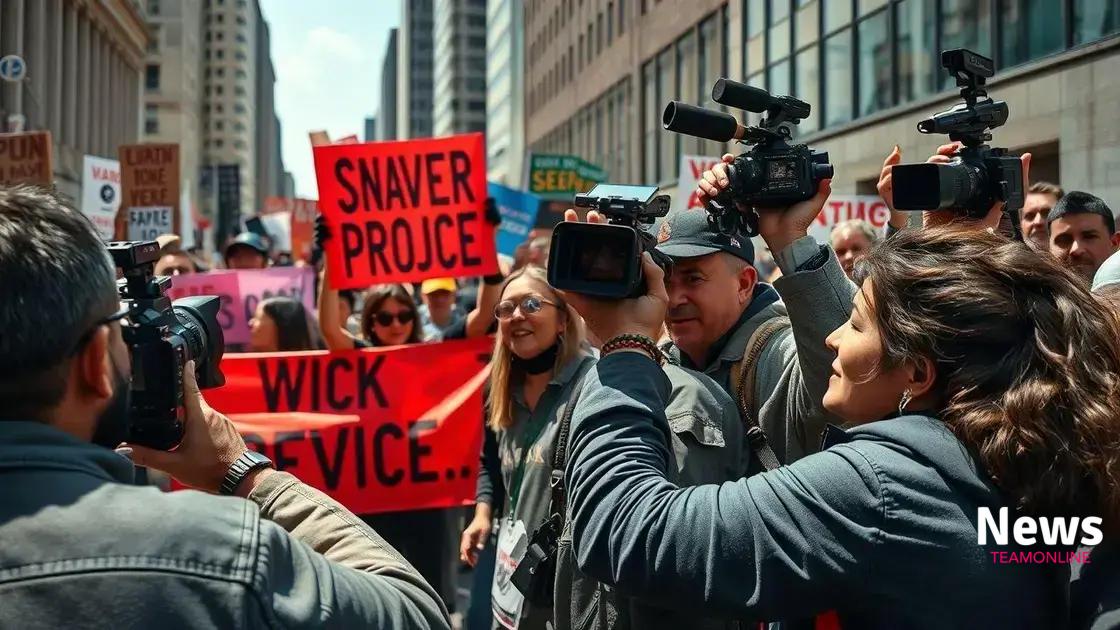
Examples of impactful media coverage can provide valuable insights into how media framing affects public opinion and protest narratives. Different coverage styles can lead to varying perceptions and responses from the audience.
Case studies in media coverage
One significant example is the coverage of the Black Lives Matter movement. Major news networks provided extensive coverage that highlighted police interactions with protesters. This focus shifted public attention toward issues of racial inequality and police brutality. The portrayal of peaceful protests alongside instances of violence allowed a deeper understanding of the movement’s complexities.
- Media highlighted personal stories of those affected by police violence.
- Visuals of large gatherings promoted feelings of solidarity.
- Negative framing of disruptors overshadowed peaceful messages.
- Social media played a role in amplifying these narratives.
Another example is the coverage of environmental protests, such as those supporting climate change action. Media representations often emphasize the urgency of climate issues and the actions taken by activists. By focusing on striking visuals of protests, such as large crowds and creative banners, the media draws in viewers and encourages discussions about climate change on broader platforms.
The role of visual storytelling
Visual storytelling is essential in impactful media coverage. Powerful images can evoke emotional responses and draw attention to key issues. For instance, pictures of young activists advocating for climate action often resonate with viewers. These images not only capture public interest but also help convey the seriousness of the cause.
Media coverage examples show how specific framing can influence public perception and response. The framing of a protest can turn it from a local event into a national conversation. By focusing on personal stories and dramatic visuals, media can transform simple protests into movements that demand change.
Challenges in accurate protest reporting
Challenges in accurate protest reporting are numerous and can significantly affect public perception. The dynamic nature of protests often leads to rapid developments, making it difficult for journalists to capture the full story. In addition, the pressures of time and the demand for immediate news can result in incomplete or biased reporting.
Reporter safety and access
Safety is a major concern for reporters covering protests. Journalists often find themselves in volatile situations where they may be at risk of injury or arrest. This can limit their ability to gather accurate information. When reporters cannot safely access a protest, they may rely on second-hand accounts or social media, which can lead to misinformation.
- Risk of physical harm affects reporting quality.
- Lack of access can limit perspectives captured in stories.
- Dependence on social media creates opportunities for misunderstanding.
- Journalists may face threats that impede their work.
Furthermore, the emotional climate of protests can lead to reactive journalism. In high-tension environments, reporters may focus primarily on sensationalist elements, like clashes or violence, rather than the underlying issues at hand. This approach can oversimplify complex social movements and mislead public understanding.
Bias and framing issues
Bias in reporting is another challenge. Different media outlets may have distinct political leanings, which can color their coverage of protests. A story framed from a specific angle can greatly influence how the audience perceives the event. For example, coverage that emphasizes property damage may incite fear, while coverage that highlights peaceful demonstrations can foster empathy and support.
Finally, the fast-paced world of digital journalism encourages short stories that may lack depth. Reporters are often compelled to produce content quickly, which can lead to missing vital context. The result is that readers may not receive a thorough understanding of the issues surrounding a protest.
The influence of social media on protest framing
The influence of social media on protest framing is a significant aspect of modern activism. Unlike traditional media, social media platforms allow for instant sharing of information, opinions, and images. This immediacy can shape narratives quickly and widely, impacting how protests are perceived by both local and global audiences.
Real-time updates and citizen journalism
Social media enables activists to share real-time updates during protests. This form of citizen journalism allows for diverse perspectives and firsthand accounts to surface. By using hashtags, individuals can unify their messages and draw attention to specific issues. For example, hashtags like #BlackLivesMatter and #ClimateStrike have helped mobilize support and spread awareness.
- Users can share live videos to document events as they unfold.
- Posts can go viral, reaching millions in minutes.
- Activists can counter false narratives quickly by sharing facts.
- Online communities often provide support and organize further actions.
However, this rapid spread of information can also lead to misinformation. When information is shared without verification, it can distort the realities of protests. False images and misleading captions can create panic or misrepresent the goals of activists. As a result, social media can sometimes contribute to confusion rather than clarity.
Framing through visual content
Visual content plays a crucial role in how protests are framed on social media. Images and videos that capture powerful moments can evoke strong emotional responses from viewers. A striking image of a protester holding a sign can tell a story that resonates deeply with viewers, while those focused on police clashes might generate fear or outrage.
The use of memes and graphics also helps convey messages quickly. Activists can distill complex issues into digestible formats, making it easier to share ideas. This can create a strong sense of community among users who feel passionate about the same causes. Likewise, the creative use of visual content can help activists engage with younger audiences who primarily consume information through their devices.
FAQ – Frequently Asked Questions about Media Framing in Protest Coverage
How does media framing impact public perception of protests?
Media framing shapes how protests are viewed, often highlighting specific aspects that influence whether the public sees them as movements for justice or disturbances.
What role does social media play in modern protest narratives?
Social media enables real-time sharing of information and citizen journalism, allowing diverse viewpoints to emerge while also posing risks for misinformation.
What challenges do journalists face when reporting on protests?
Reporters often face safety risks and the pressure to deliver immediate news, which can lead to incomplete or biased reporting.
How can visual content affect the understanding of protests?
Powerful images and videos can evoke strong emotional responses and shape narratives, influencing public opinions about the issues at stake.

